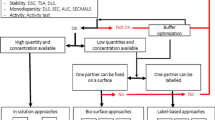Abstract
The Microscale Thermophoresis (MST) is a biophysical method to characterize biomolecular interactions in bulk solution. Interaction affinities can be quantified in biological liquids, without immobilization and without a size or mass limitation. Its material consumption is very low and today’s resolvable dissoziation constants range from Kd = 100 pM to Kd = 10 mM.
Similar content being viewed by others
Literatur
Duhr S, Braun D (2006) Why molecules move along a temperature gradient. Proc Natl Acad Sci USA 103:19678–19682
Baaske P, Wienken CJ, Reineck P et al. (2010) Optical thermophoresis for quantifying the buffer dependence of aptamer binding. Ang Chem Int Ed 49:2238–2241
Wienken CJ, Baaske P, Rothbauer U et al. (2010) Protein binding assays in biological liquids using microscale thermophoresis. Nat Commun 1:100
Wang X, Corin K, Baaske P et al. (2011) Peptide surfactants for cell-free production of functional G protein-coupled receptors. Proc Natl Acad Sci USA 108:9049–9054
van den Bogaart G, Thutupalli S, Risselada JH et al. (2011) Synaptotagmin-1 may be a distance regulator acting upstream of SNARE nucleation. Nat Struct Mol Biol 18:805–812
Wienken CJ, Baaske P, Duhr S et al. (2011) Thermophoretic melting curves quantify the conformation and stability of RNA and DNA. Nucleic Acids Res 39:e52
Author information
Authors and Affiliations
Corresponding author
Additional information
Moran Jerabek-Willemsen Jahrgang 1976. 2005 Biologiestudium (Diplom), Universität Düsseldorf. 2010 Promotion am Universitätsklinikum Essen. Seit 2010 Applikations-Spezialist bei NanoTemper.
Stefan Duhr Jahrgang 1980. 2004 Biochemiestudium (Diplom), Universität Witten/Herdecke. 2007 Promotion an der LMU München. Seit 2008 Gründer und Geschäftsführer von NanoTemper.
Philipp Baaske Jahrgang 1979. 2005 Physikstudium (Diplom), Universität Bayreuth. Seit 2008 Gründer und Geschäftsführer von NanoTemper. 2010 Promotion LMU München.
Rights and permissions
About this article
Cite this article
Jerabek-Willemsen, M., Duhr, S. & Baaske, P. Biomolekulare Interaktionen: Manche mögen’s heiß. Biospektrum 18, 30–32 (2012). https://doi.org/10.1007/s12268-012-0139-2
Published:
Issue Date:
DOI: https://doi.org/10.1007/s12268-012-0139-2




